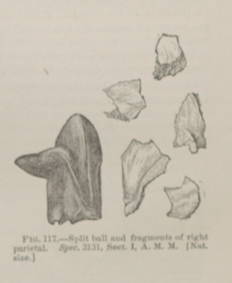Title: B——, William
Source text: Surgeon General Joseph K. Barnes, United States Army, The Medical and Surgical History of the War of the Rebellion. (1861–65.), Part 1, Volume 2 (Washington, D.C.: Government Printing Office, 1870), 247.
Civil War Washington ID: med.d1e16283
TEI/XML: med.d1e16283.xml
CASE.—Private William B——, Co. G, 8th Pennsylvania Cavalry, aged 18 years, was wounded in an engagement at Deep Bottom, Virginia, August 14th, 1864, by a conoidal ball, which fractured and depressed the posterior portion of both tables of the right parietal bone. The ball, which was split from apex to centre, was found impacted on the edge of the fracture and was removed on the field. He was admitted, on the following day, to the hospital of the 2d division, Cavalry Corps, and thence conveyed to Washington, where he entered the Emory Hospital, August 17th. Cold water dressings were applied, the head kept cool by constant application of iced water, and low diet ordered. On the morning of the 20th, there were symptoms of compression; pulse 88, slow and soft. Chloroform was administered and Surgeon N. R. Moseley, U. S. V., removed five small fragments of bone which had become detached, and elevated the depressed bone. The soft parts were quite extensively lacerated. A strictly antiphlogistic course of treatment was established, and the patient remained comfortable until the evening of the 23d, when febrile symptoms of a severe character occurred; death supervened on August 25th, 1864. An autopsy showed extensive disorganization of the brain; the middle lobe of right hemisphere was in a suppurating condition, and the diseased action had extended as far back as the base of the brain. The pathological specimen is shown in the wood-cut, and was contributed by the operator, Surgeon N. R. Moseley, U. S. V.
